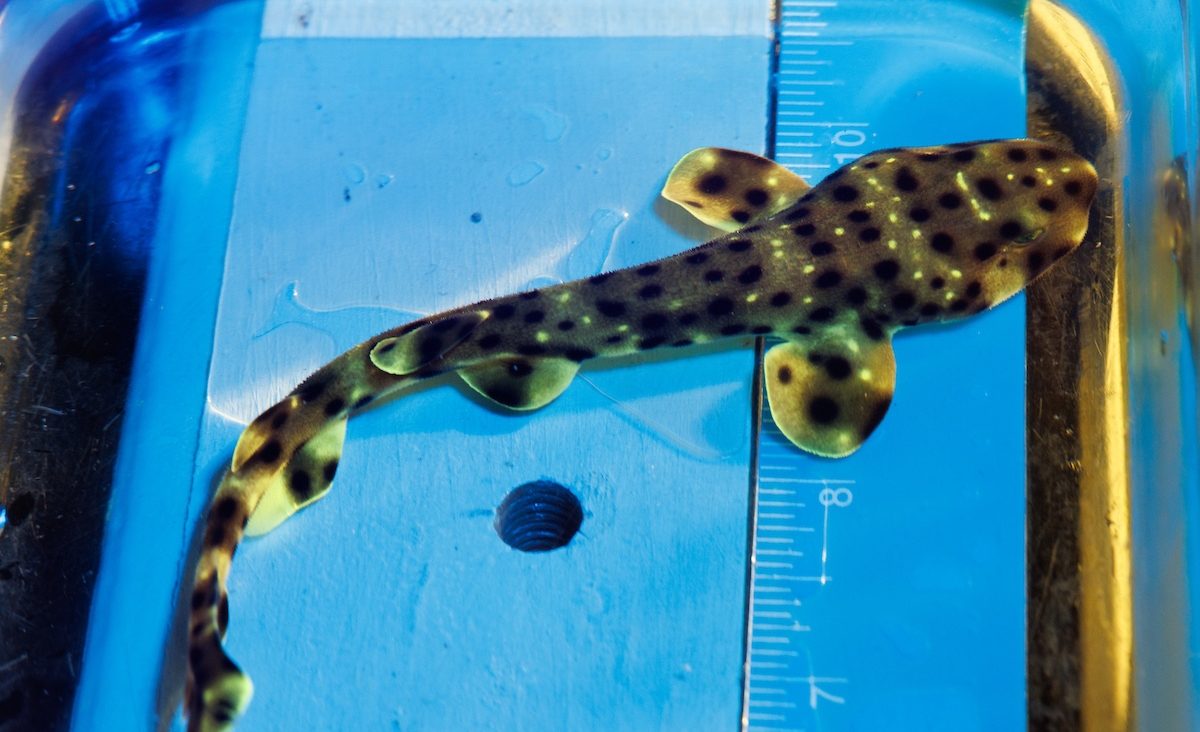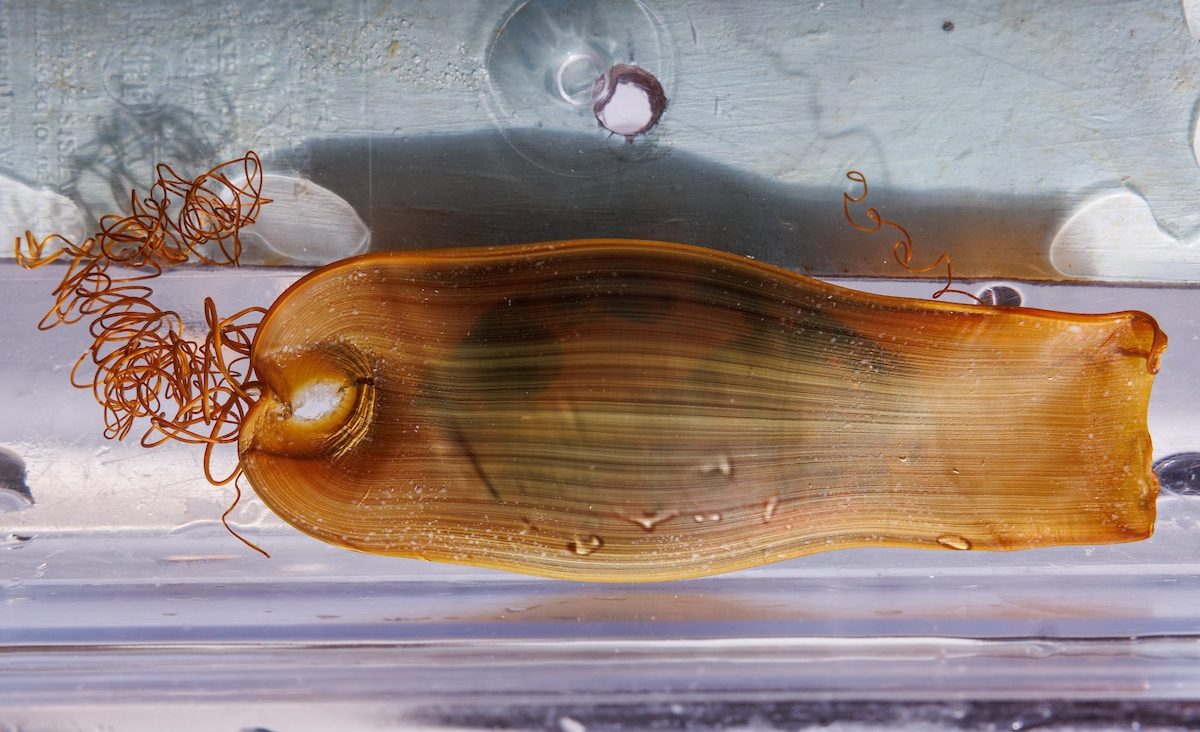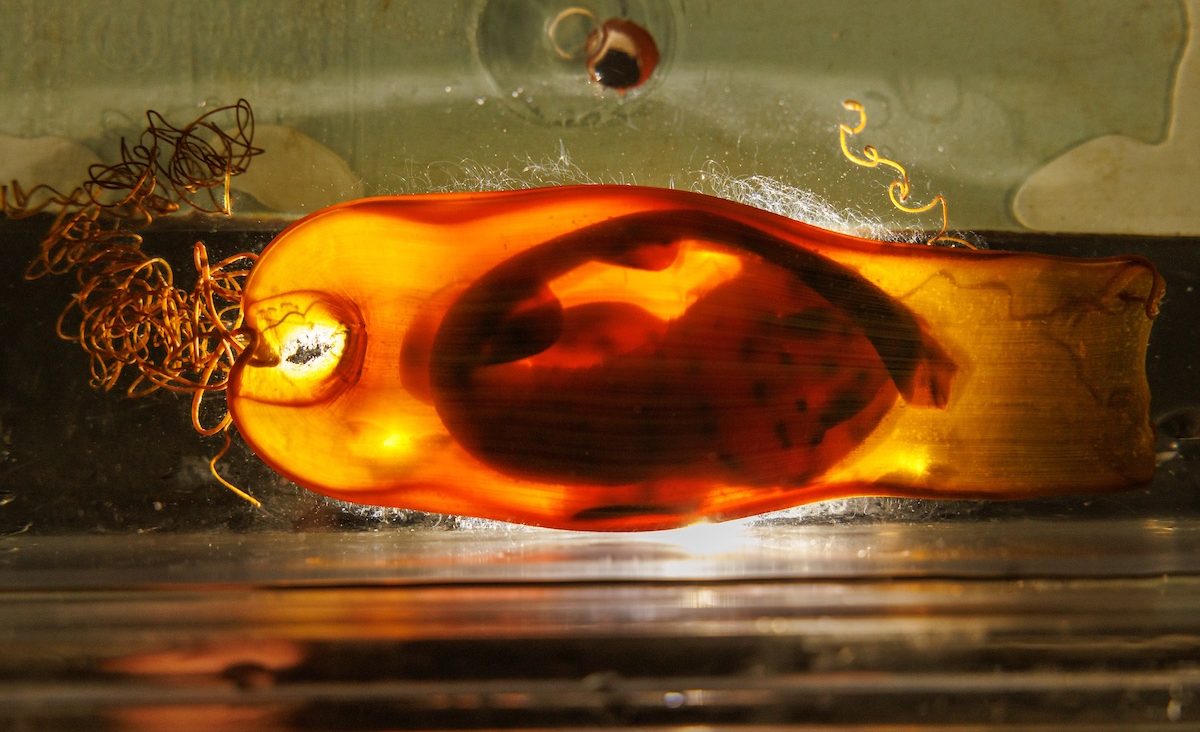Chattanooga, Tenn. (July 24, 2023) – Recently, a senior aquarist checking in on off-exhibit systems at the Tennessee Aquarium made an unexpected — and illuminating — discovery just in time for this year’s Shark Week celebration.
There, swimming alongside a pair of adults, was a baby Swell Shark. Colloquially known as “glow sharks,” this mottle-patterned species has developed a novel way to see others of its kind in the cold, dark depths off the Pacific coastline from California to Mexico.
“We call them that because they biofluoresce — they don’t make their own light, but they reflect light in a fluorescent manner,” says Senior Aquarist Kyle McPheeters, who first spotted the four-inch youngster.

A recently hatched Swell Shark pup demonstrates its biofluorescence under a blacklight. This species has specially adapted eyes that filter out wavelengths of light to more easily see and recognize other sharks in deep, dark water.
Using a handheld ultraviolet light and a pair of yellow glasses, McPheeters simulates what the sharks’ specially adapted eyes would see when looking at each other. Under the blue beam, the baby Swell Shark becomes hyper-visible, its body exuding a ghostly green luminance that starkly emphasizes its pattern of light and dark dots.
By the time it’s full-grown, this baby could reach up to three feet in length. The species’ unusual name references its defensive tactic of swallowing sea water to increase its body size to intimidate and deter would-be predators.
Hatching the Swell Shark was also a first for McPheeters, who is a veteran caretaker of many different species of sharks and rays.
In addition to caring for Sandbar Sharks and Sand Tiger Sharks in the Aquarium’s 618,000-gallon Secret Reef exhibit, McPheeters tends to many sharks in the Stingray Bay touch experience, whose residents include Japanese and California Horn Sharks, Coral Catsharks and Epaulette Sharks. In his career, McPheeters has hatched and raised 90 Epaulettes, many of which are now exhibited at other Aquariums around the country, but this baby is his first Swell Shark.

A Swell Shark egg case, also known as a “mermaid’s purse,” at the Tennessee Aquarium. The pup developing inside will be only a few inches long once hatched but could reach up to three feet in length as an adult.
The arrival of a baby shark is always worth celebrating, whether if it’s the first or the ninety-first, he says.’
“When we have eggs coming from the adults, that’s exciting in itself, because it means we have a healthy environment where they feel safe reproducing,” McPheeters says. “But then to come in and see that come full circle and come to fruition with a baby shark hatching from its egg is really exciting.”
As of 2015, Swell Sharks were classified as “least concern,” the lowest threat level assigned by the International Union for Conservation of Nature (IUCN). However, according to a 2021 study published in the journal Nature, shark populations have been in steep decline over the last 50 years due to human activity, mainly over-fishing. Since 1970, shark and ray populations have been reduced by 71 percent, according to the report.
By introducing sharks to hundreds of thousands of people every year, zoological facilities like the Tennessee Aquarium help debunk misconceptions of sharks as dangerous and highlight their ecological importance, McPheeters says.

A Tennessee Aquarium aquarist shines a light through the egg case of a Swell Shark. Known as “candling,” this process allows caretakers to check on pups to gauge their stage of development.
“Sharks play a vital role in the ocean,” he says. “Just like land-based predators such as wolves and lions, they help to balance the food web and keep animal populations healthy by weeding out sick or injured individuals.”
For the time being, the Aquarium’s baby Swell Shark will remain with its parents and other juveniles in its off-exhibit home. Guests anxious for a jaw-some encounter during their visit to the Aquarium can see the many other species McPheeters cares for in the Secret Reef exhibit and Stingray Bay touch experience.
Another fin-tastic way to scratch your shark itch is by tuning into the Aquarium’s always-live Secret Reef web cam, which offers views of this colossal exhibit’s Sandbar Sharks and Sand Tiger Sharks as well as many other marine species. Check it out at tnaqua.org/live/secret-reef/